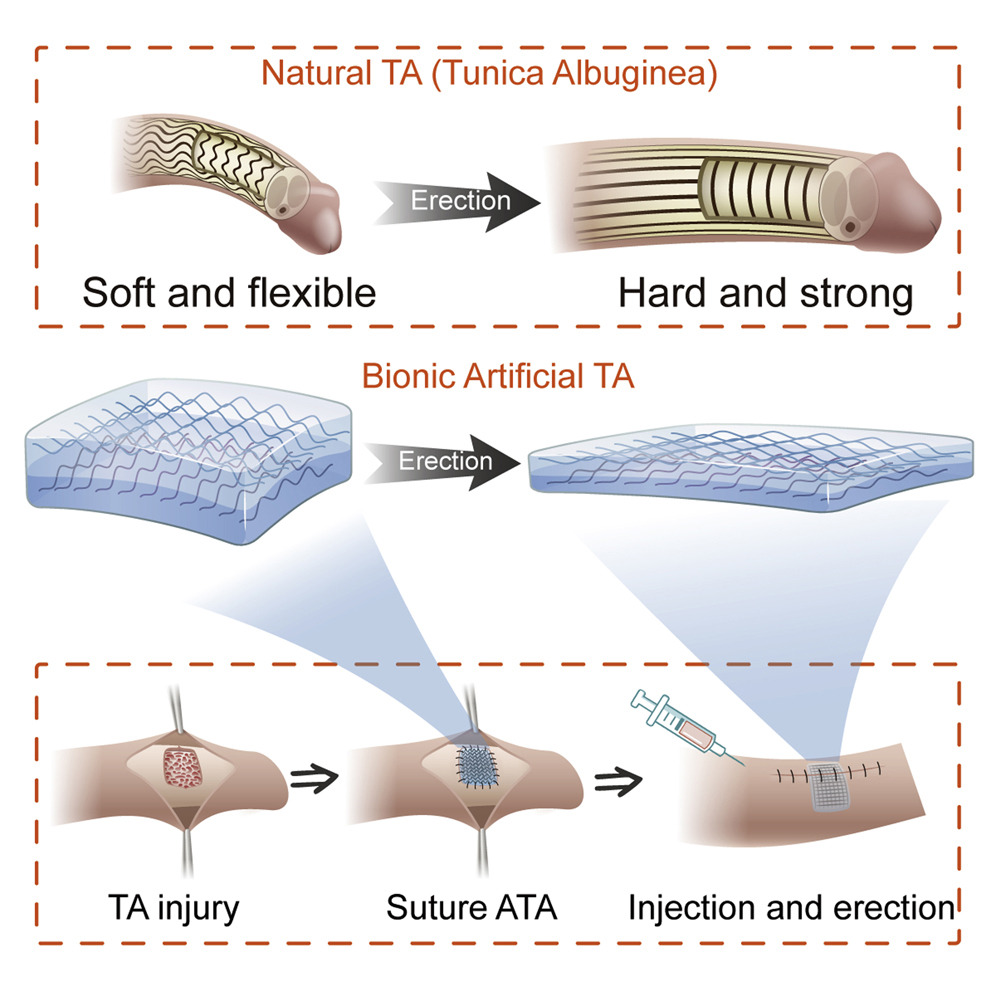Medtech
Bionic Penis Restores Erections in Pigs
Scientists have remolded isotropic polyvinyl alcohol hydrogels into double-layered elastic patches composed of parallel curved fibers with anisotropic…

Inspired by the natural and unique strain-adaptive properties of a tissue that forms the outer sheath of the mammalian penis, scientists in China have created an artificial penile implant that consists of aligned but crimped fibers crosslinked in a hydrogel that can stiffen under strain and restore normal erections in a porcine model.
The mammalian penis consists of an external, tough but flexible connective tissue (tunica albuginea, TA) that envelops the erectile tissue (corpus cavernosum) and the urethra. The double-layered TA consists of stacked parallel wavy collagen fibers and embedded elastic fibers in an outer longitudinal and an inner circular layer. The TA forms the hydrostatic framework that is critical for penile erections. During an erection, the curved TA fibers sequentially straighten to absorb strain and stretch to orchestrate the transition from soft to firm.
Damages to the TA due to Peyronie’s disease, injury, or aging can cause problems such as bending of the penis, painful erections, and difficulties in sexual intercourse. Such problems require surgery to remove fibrous plaques from the TA, causing the penis to shorten. Implanting a patch graft after removing fibrous plaques decreases or prevents such shortening.
At present, surgeons use tissues and extracellular matrix (ECM) from the patient’s own body (autologous grafts) for penile patch implants. Some studies have even experimented with xenografts such as porcine bladder ECM to fabricate TA patches, but their success has been limited due to immune rejection, donor site complications, and contraction of the implant. The limited success of both autologous and xenografts in filling in for the mechanical and morphological requirements of the TA and achieving normal erectile function, is largely due to the inherent differences between the microstructure of the implanted graft and the natural TA tissue.

during penile erection (Chai M, et al, Matter, 2023).
In a study published in the Cell press journal, Matter “Bionic artificial penile Tunica albuginea,” scientists at the South China University of Technology, have remolded isotropic PVA (polyvinyl alcohol) hydrogels into double-layered elastic patches composed of parallel curved fibers with anisotropic stretching properties that recapitulate the crimped microstructure of natural TA. The authors demonstrated the ability of the artificial tunica albuginea (ATA) to repair injuries and restore normal erectile function in a pig model with damage to the TA of the penis.
“ATA has great promise for penile injury repair,” the authors noted. “ATA possesses several key mechanical features of natural TA, including rapid strain stiffening over small intervals of deformation, excellent fatigue resistance to sustain cyclic bursts, and high toughness to withstand pointwise acupuncture during suturing.”
The researchers were able to generate the ATA by stretching the isotropic PVA gel before covalently crosslinking its constituent fibers to permanently fix the parallel aligned curved structures.
“This ATA fabrication strategy is highly innovative as it integrates both axial and radial stretching properties to the ATA implant,” said Ghanashyam Acharya, PhD, an associate professor of surgery at Baylor College of Medicine, whose own research focuses on designing polymer scaffolds for soft tissue repair. (Acharya was not involved in the current study).
“Since the ATA is fabricated using biocompatible crosslinked PVA polymer that is already in clinical use for different surgical applications, the bionic ATA implant will have a very high potential for clinical translation,” said Acharya. “Upon successful development, ATA can provide an effective, readily scalable, and biocompatible synthetic replacement (implant) for the injured tunica albuginea and obviate the need for the use of autologous tissues and extracellular matrix (ECM) based implants.”
The novel approach of mimicking natural tissue cytoarchitecture adopted in this study to produce a bionic penis, could potentially be employed to build a variety of weight-bearing structures that match the performance capacities of natural tissues.
The post Bionic Penis Restores Erections in Pigs appeared first on GEN – Genetic Engineering and Biotechnology News.

ETF Talk: AI is ‘Big Generator’
Second nature comes alive Even if you close your eyes We exist through this strange device — Yes, “Big Generator” Artificial intelligence (AI) has…
Apple gets an appeals court win for its Apple Watch
Apple has at least a couple more weeks before it has to worry about another sales ban.
Federal court blocks ban on Apple Watches after Apple appeal
A federal appeals court has temporarily blocked a sweeping import ban on Apple’s latest smartwatches while the patent dispute winds its way through…














